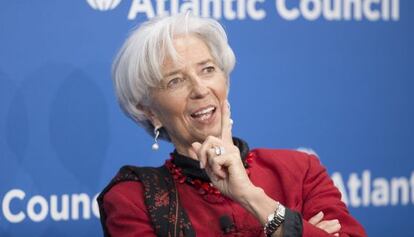IMF ups 2015 growth forecast to 2.5%
Unemployment is still expected to remain above 20% this year and the next


Spain is simultaneously competing with Britain in economic growth and battling Greece for the title of European country with the highest unemployment rate.
That was the black-and-white snapshot of the Spanish economy provided by the International Monetary Fund (IMF) on Tuesday in Washington.
According to the world body, Spain’s economic output will grow 2.5 percent this year and two percent in 2016, representing the fastest growth rate in the euro zone.
In just three months, the IMF has raised its Spanish growth forecast for 2015 by half a percentage point
Yet joblessness is expected to remain above 20 percent even after 2016.
In just three months, the IMF has raised its Spanish growth forecast by half a percentage point, and added two tenths of a point to its 2016 predictions.
It took analysts at the Washington-based agency a while to convince themselves that domestic demand would be strong enough to contribute to the recovery, following years of cuts, wage devaluations and job destruction.
But demand is growing, with even the construction sector contributing to GDP for the first time since the real estate bubble burst. To this must be added favorable outside circumstances such as lower oil prices, the depreciation of the euro and a stimulus package from the European Central Bank.
All of these factors have led to the seventh consecutive upward revision of the IMF’s growth forecast for Spain. Yet despite the agency’s global influence, its studies must be taken with a pinch of salt: a comparison by the Esade business school of 24 expert analyses showed the IMF to have made some of the most erroneous predictions regarding the Spanish economy’s performance in 2014, predicting 0% growth in the fall when the real figure was 1.4%.
The IMF’s new forecast still falls short of the Spanish government’s optimistic talk of 3% growth, but adds two tenths of a point to the European Commission’s belief that Spain’s GDP will grow 2.3%.
5.4 million out of a job
Meanwhile, Spain managed to create 434,000 jobs last year for the first time since the crisis began, but there are still 5.4 million people without the means to make a living, according to late 2014 figures. This puts the unemployment rate at 23.7%.
According to the IMF, the 2.5% growth will only help reduce the jobless rate by two tenths of a point, leaving the latter at 22.6% in late 2015 and 21% by the end of 2016.
If this pace of job creation held steady, it would still take over eight years to get back to pre-crisis levels.
The IMF will review its forecasts again in July, and may adjust its numbers for Spain again. By then, the effects of the ECB’s massive debt purchases will be felt. The move hopes to stimulate economies and stop prices from dropping. According to the IMF, Spain is the euro-zone country most at risk of deflation.
Tu suscripción se está usando en otro dispositivo
¿Quieres añadir otro usuario a tu suscripción?
Si continúas leyendo en este dispositivo, no se podrá leer en el otro.
FlechaTu suscripción se está usando en otro dispositivo y solo puedes acceder a EL PAÍS desde un dispositivo a la vez.
Si quieres compartir tu cuenta, cambia tu suscripción a la modalidad Premium, así podrás añadir otro usuario. Cada uno accederá con su propia cuenta de email, lo que os permitirá personalizar vuestra experiencia en EL PAÍS.
En el caso de no saber quién está usando tu cuenta, te recomendamos cambiar tu contraseña aquí.
Si decides continuar compartiendo tu cuenta, este mensaje se mostrará en tu dispositivo y en el de la otra persona que está usando tu cuenta de forma indefinida, afectando a tu experiencia de lectura. Puedes consultar aquí los términos y condiciones de la suscripción digital.








































